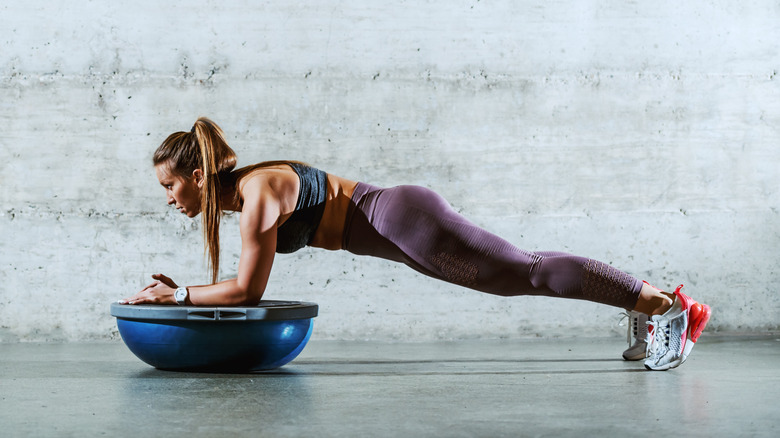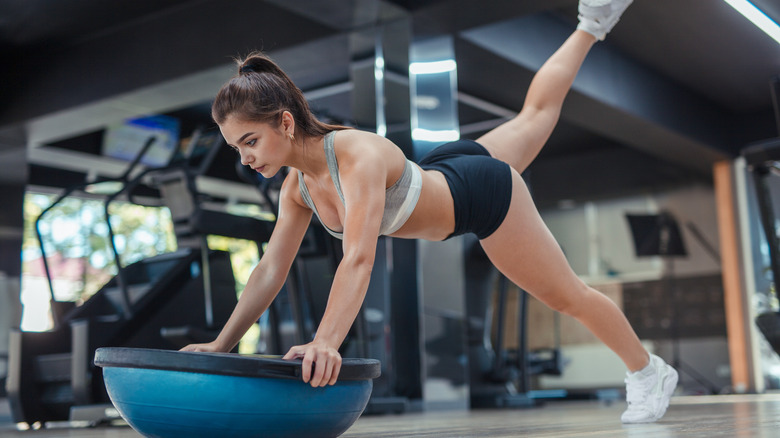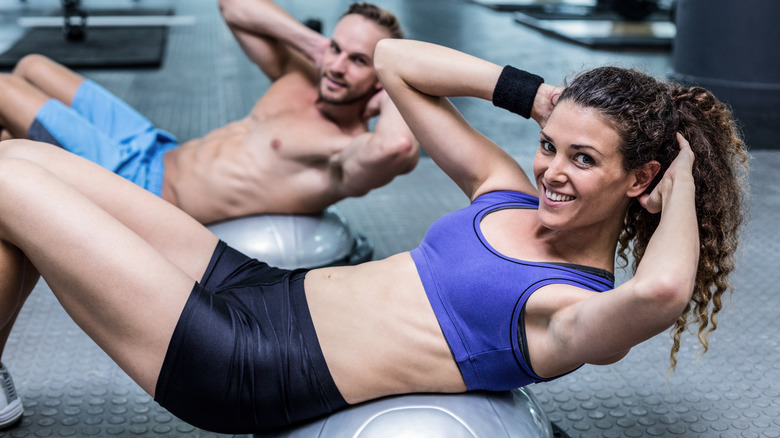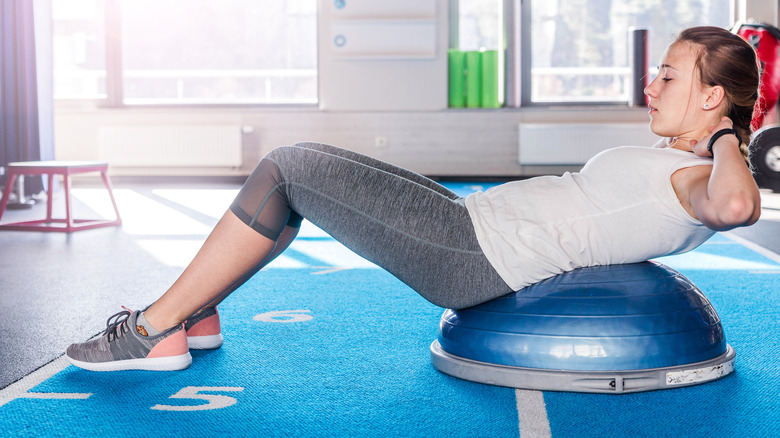What Is A BOSU Ball (And How Can It Help Strengthen Your Core?)
If you've ever encountered a Bosu ball in your gym, you might have been a little perplexed at first. The smooth base appears to have handles, but you're pretty sure you've seen people standing on them. If you stood on it, which side would you even choose? No one can fault you for not being comfortable with a Bosu ball.
Stability balls (also called Swiss Balls), on the other hand, are pretty common, thanks to their resurgence in popularity as an alternative to a desk chair. Their odd cousin, the half-stability ball, is less familiar to most. But you'll want to familiarize yourself with this relative and fast because Bosu balls can have your core shaking and sweating in no time. Bosu balls seem to be everywhere these days: They've come a long way from their beginnings in physiotherapy practices, where they helped with body awareness (or proprioception) and recovery after injuries and have taken up regular residence in gyms. Before you try a Bosu ball, it's important to know a few things.
What is a Bosu ball?
A Bosu ball looks like you took a large cardio drumming or fitness ball, cut it in half, and attached it to a platform. In essence, that's what it is. Bosu, pronounced "bo-sue," stands for both sides up. Looking at one, you can tell why the name is very fitting: The ball, which actually isn't a ball at all, can be used with either side facing upwards.
It is meant for stability training, and regardless of which side you face upward, it will definitely test your balance. Bosu balls come in a few different sizes, with the classic measuring 65 centimeters in diameter and a dome around 8.5 inches high. You can also find smaller, "travel-sized" Bosu trainers, though they're not ideal for regular training in the gym.
There are also different features you can opt for when browsing Bosu balls. For example, the Bosu NextGen trainer offers a texturized, non-slip surface compared to smoother standard models. You can also choose your color and up your game with removable handled tension straps if you so desire. In most cases, though, the look of your ball doesn't change how you use it, as the Bosu ball is designed to be a multifunctional piece of workout equipment all on its own.
Bosu balls for a better core
As a stability trainer, a Bosu ball can be excellent for your core. Every time you encounter an uneven surface, your body is forced to adjust and compensate. Usually, your core is largely responsible for stabilization. Whether standing or planking on the wobbly surface, it instantly engages various muscle groups, especially your core.
Beachbody trainer and founder of 80-Day Obsession Autumn Calabrese told Self that a Bosu trainer lets you do "everything from leg exercise balancing on it, to core exercises and even upper-body and cardio work," all the while calling on those small muscles in your abdomen to keep you balanced and stable. Doing crunches just doesn't have that same instability element. This feature allows the Bosu ball to help increase your sense of body awareness, promote good posture, and better your form during exercises, all while strengthening your muscles.
Not to deflate your enthusiasm, but the Bosu ball isn't great for every exercise. Calabrese advises that anything that "has you lifting a lot of weight and doesn't leave your hands free in case you fall" isn't recommended (via Self). Here's looking at you, heavy-racked dumbbell squats. Nevertheless, you can do a wide range of exercises with a Bosu ball that will have all the benefits of the traditional movement plus core stabilization.
Certified Bosu ball bangers
If you want to liven up your workout and light up your abdominal muscles with a Bosu trainer, give these movements a try.
Planks are a great basic exercise to start with. Flip the ball so that the dome is on the ground. While on your knees, place your hands on either side of the hard, flat surface with your palms under your shoulders and your hands gripping the edges. Then, extend your legs behind you so your feet are positioned on your toes, just like a standard plank. Keeping a straight line from the back of your head to your heels, tighten your quads, glutes, and core. Hold for 30 seconds and release. Using this same setup, you can also try mountain climbers or push-ups.
Standing on the ball helps to work your fast-twitch muscles as they try to maintain stability. Generally, you'll want to start by placing the hard, flat surface on the floor and standing on the domed ball portion. Doing this by a wall for support if you're nervous about balance can be a good idea. With your feet hip-width apart and your hands on your hips, lower into a squat keeping your chest lifted, back flat, and core tight. Then, rise to stand as you push through your heels and squeeze your glutes. From the same starting position, you can also attempt reverse lunges or even just knee raises, lifting one foot off the ball at a time.
Can Bosu balls be bad?
We know that Bosu balls are a hot commodity in gyms, but because you can perform a variation of almost any exercise on them, some trainers argue that they're over-used and used incorrectly.
There might be some truth to this. For example, if you want to get stronger, you usually need to progressively increase the weight you lift, per Healthline. If you perform all your movements on an unstable Bosu ball, you likely can't increase your weight as by as much. Slower progression in how heavy you can lift makes Bosu balls not ideal for those who are solely focused on muscle mass gain. Additionally, you generally can't use as much lifting force as you would on a flat, stable surface: Less power in your movements means sticking to lighter weights and reducing your progressive load training. If you decide to try and lift heavy anyway, there is a good chance that all of the focus on balancing could compromise your form. It's usually best to skip the heavy deadlifts or bulky racked squats while on a Bosu ball.
That being said, ab work tends to not use a ton of weight and relies on higher reps, making it one of the categories of exercise that instability can aid instead of hinder.
Gimme, gimme, core!
Does Britney Spears use a Bosu ball? We don't know, but if you want to tone your abs specifically, consider traditional core movements on the Bosu ball.
Bosu ball sit-ups, for example, can be done with the flat side of the ball on the ground. Sit so you're not directly on top but halfway between the midpoint and the floor. Assume the standard crunch position, with your knees slightly bent, feet out in front of you, and your hands behind your head. Lie back, relaxing your abs, then engage your core to raise your upper body, drawing your chest towards your knees with an upward gaze to stay lifted. From the same crunch position, you can try bicycle crunches to target your obliques or single-leg toe touches, which help to bring your lower abs into the mix.
Though, don't limit yourself to typical ab exercises when it comes to the Bosu ball. Pretty much any movement you do on its unstable surface will engage your abdominals, making the Bosu ball a core superstar for your gym routine.




